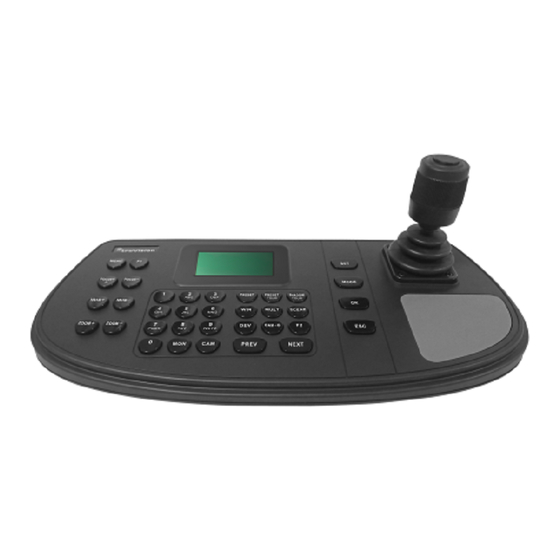
TruVision TVK-600 Operator's Manual
Hide thumbs
Also See for TVK-600:
- Operator's manual (3 pages) ,
- Quick start manual (4 pages) ,
- Configuration manual (53 pages)
Advertisement
Quick Links
TruVision TVK-600 Operator Guide: Keyboard
Mode
Introduction
This guide explains how to control cameras, recorders,
and decoders/encoders using the Keyboard mode of
TVK-600 keypad.
The Keyboard mode is one of four modes available in
the keypad that can be used to control devices. This
guide only describes how to use the Keyboard mode.
There are separate operator guides for the other modes.
See Table 1 below for the list of devices that are
supported by the Keyboard mode.
Table 1: List of TruVision devices supported
by Keyboard mode
TruVision cameras:
TruVision non PTZ IP cameras
TruVision IP Compact PTZ cameras
TruVision IP Full Size PTZ cameras
TruVision Stainless Steel IP PTZ cameras
TruVision TVI PTZ cameras
TruVision recorders:
TVN 21
TVN 22
TVR 15HD
Note: TruVision non PTZ IP cameras and encoders are
not supported by this mode except as an input.
Before you start
Before you can take control of a device with the keypad,
you first need to tell the keypad which devices to control.
Every device added to the keypad must have a unique
ID. You need to tell the keypad the specific recorder,
decoder/encoder, monitor, and camera that you want to
control.
You enter the ID of the recorder or decoder (DEV), then
that of the monitor (MON), and then that of the camera or
P/N 1073653-EN • REV B • ISS 29JUN21
TVR 16
TVR 45HD
TVR 46
encoder (CAM) to be controlled. This ID information is
provided by your manager.
DEV: The ID of the recorder or decoder you want to
control.
MON: This is the ID of the monitor you want to control.
CAM: This is the ID of the camera or encoder you want
to control.
Important! Before you start using the keypad to control
devices, ensure that you have received from your
manager the list of device IDs that you will be using and
that they are categorized by recorder/decoder (DEV),
monitor (MON), and camera (CAM) (and camera groups
CAM-G if using a decoder). You also should receive the
list of multiscreen (MULT) and window (WIN) formats
available for each recorder that you can control.
Note: The text in the keypad's LCD screen is only
available in English.
Controling devices
To control devices using the Keyboard mode:
1. Power-up the keypad and press the button on top of
the joystick to get the login screen. Enter your name
and password to log in to the keypad.
Note: In the Login dialog box, if you enter the wrong
password five times, you will be locked out for 30
minutes.
2. Press the
MODE
button on the keypad.
The LCD display lists the four keypad operation
modes to control devices (see Figure 1 on page 2).
3. Press the numeric button
PREV/NEXT
to scroll up/down the list, to select
Keyboard
mode and press OK.
I
(one) or press
1
Advertisement

Subscribe to Our Youtube Channel
Summary of Contents for TruVision TVK-600
- Page 1 TVR 46 Note: In the Login dialog box, if you enter the wrong Note: TruVision non PTZ IP cameras and encoders are password five times, you will be locked out for 30 not supported by this mode except as an input.
- Page 2 Table 2: How to control a camera using Keyboard mode Numeric Keypad Action button button Press the numeric button(s) for the ID of the desired decoder or recorder and this function button to select the decoder or recorder. TruVision TVK-600 Operator Guide: Keyboard Mode...
- Page 3 Press the numeric button(s) for a desired preset tour and this function button to call up the preset tour. Press the numeric button(s) for a desired shadow tour and this function button to call up the shadow tour. TruVision TVK-600 Operator Guide: Keyboard Mode...
- Page 4 A scene is a custom view of the decoder. This feature allows you to store predefined layouts with streams so that it is easy to call them up when needed. For more information on scenes, refer to the TruVision decoder user manual.



Need help?
Do you have a question about the TVK-600 and is the answer not in the manual?
Questions and answers